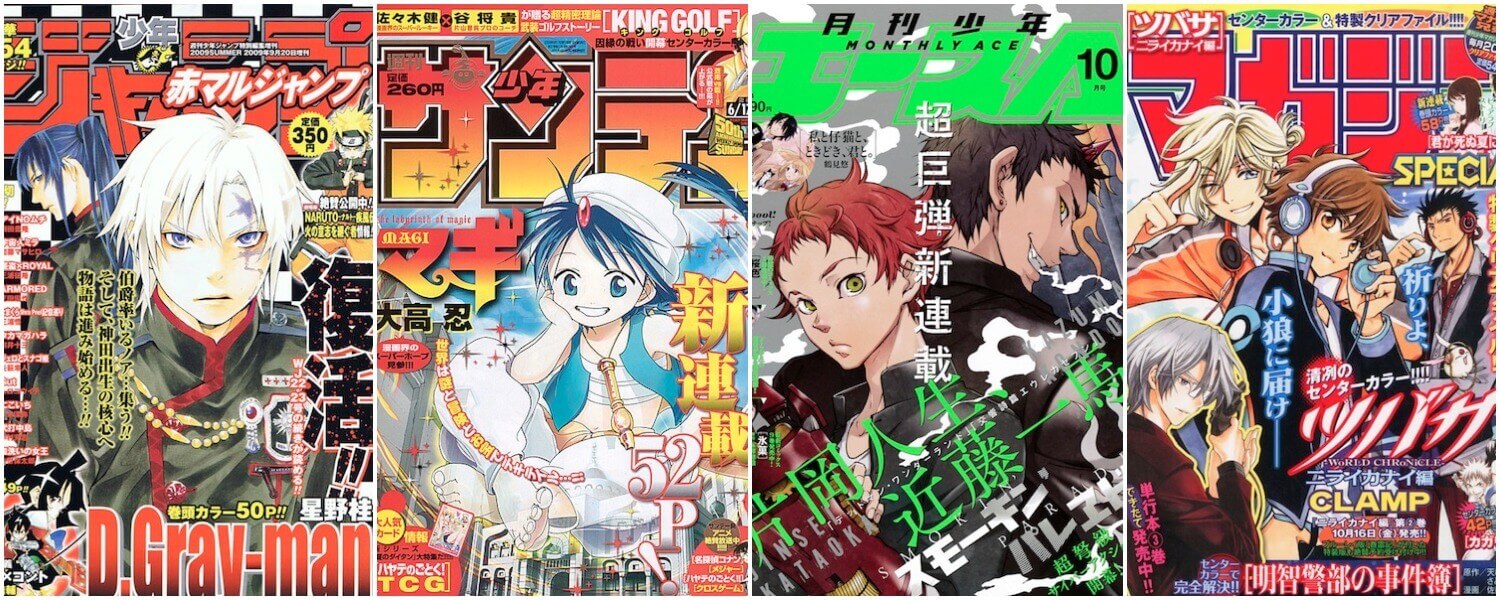While realistically anyone can read whatever manga he or she desires, most are created for a typical demographic, or they’re at least published in an anthology aimed at a particular demographic. Thus, shounen manga are aimed at boys, and shoujo manga are aimed at girls. However, just because your favorite manga may be aimed at boys doesn’t mean it’s written by a guy. Here’s a list of women mangaka who have written some of the most famous and well-received shounen series.
Rumiko Takahashi

Rumiko Takahashi is not only one of the most prolific writers of shounen manga, but she is one of Japan’s most famous mangaka. She has published eight different manga series, with her two best-seling works being Ranma 1/2 and Inuyasha. She worked on her first two ongoing series, Urusei Yatsura and Maison Ikkoku simultaneously until they both ended in 1987. Urusei Yatsura was also one of the earliest manga series to be published by Viz Media; it was released in English in 1989, with the company first publishing manga in 1987. Although Urusei didn’t sell well when it was first released, Viz’s 1992 release of Ranma 1/2 proved to be the company’s biggest success so far and pushed Rumiko Takahashi towards international fame. In 2014, she was nominated to enter the Eisner Hall of Fame, along with animation legend Hayao Miyazaki. Neither of them were inducted, unfortunately. She is currently working on her shounen series Rin-ne, which was adapted into an anime series in April 2015 and with a second season to air in 2016.
Katsura Hoshino
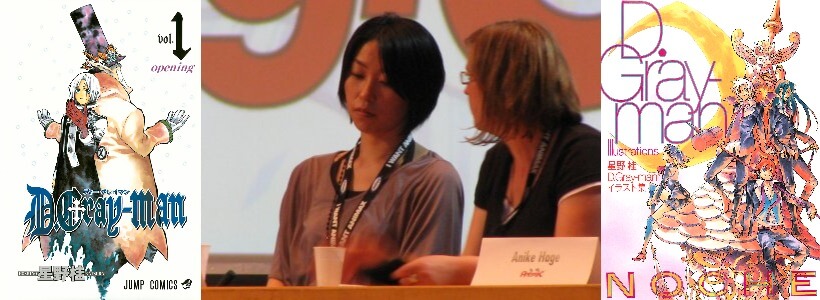
Katsura Hoshino’s most famous work-to-date would be D. Gray-man. The series follows Allen Walker and his fellow exorcists as they try to eliminate akuma (the Japanese word for “demon”) and the Millennium Earl. D. Gray-man shares many similarities with her earlier work, Zone: Allen Walker is based off of the female protagonist of Zone, the Millennium Earl is the main antagonist of both manga, and akuma and Exorcists are main concepts in both works. D. Gray-man was put on hiatus twice: the first time was due to Hoshino contracting Norovirus, a disease with symptoms that may include nausea, vomiting, abdominal pain, and aches in the muscles; the second time was due to Hoshino injuring her neck. Two manga creators that have inspired her work are Takeshi Obata (Death Note, Bakuman, Hikaru no Go) and Osamu Akimoto (Kochikame). Most recently, Katsura Hoshino created the character designs for Valvrave the Liberator, an anime produced by Sunrise that aired from April to December 2013. She also has her own Instagram account.
Hiromu Arakawa

Odds are, you know this woman’s work. Whether you’ve read the manga or seen one of the anime adaptations of it, Hiromu Arakawa has written one of the most critically-acclaimed manga in the shounen genre: Fullmetal Alchemist. Hiromu is, in fact, a pen name, though it’s not too far from her actual given name Hiromi. Arakawa was born and raised in Japan’s northernmost prefecture, Hokkaido, which she makes abundantly clear if you’ve ever read any of her biographical insertions in her work. Even her self portrait of a glasses-wearing cow references her roots growing up on a dairy farm. Her upbringing ingrained in her a dedication to hard work, one that she’s passed on into her works: “The more you love your animals, the more they give back to you. The more you take care of livestock, the better their meat will be. […] Our family motto is ‘those who don’t work, don’t deserve to eat.’ Everyone has to work hard to make ends meet, including women and kids. That’s the reason there are so many working women in Fullmetal.”
Her initial foray into manga was writing doujinshi, or fan comics. Her first published work was a one-shot titled Stray Dog, which features a girl who is part of a military experiment that turns her into a human-dog hybrid. Components from this one-shot carry over into Fullmetal Alchemist: her being a military experiment is much like Fullmetal‘s chimeras, and she and Edward Elric share the trait of golden eyes, braided hair, and being referred to as “dog[s] of the military.” Beyond Fullmetal Alchemist, Arakawa has produced quite a few other manga. Works that show her love of Chinese culture include Shanghai Youmakikai (“Ghost Demons of Shanghai”), which follows a group of demon hunters working in Shanghai, and Hero Tales, a collaborative work involving Arakawa, Genco, and Studio Flag that follows a young man named Taitou and his sister Laila as they learn about the hidden power within Taitou. Currently, Arakawa is working on Silver Spoon, a manga that revolves around Yuugo Hachiken and his life as he attends an agricultural high school, as well as the manga adaptation of Yoshiki Tanaka’s novel series The Heroic Legend of Arslan.
Her influences include Shigeru Mizuki (GeGeGe no Kitarou), Kinnikuman (released in the US as Ultimate Muscle) by Yudetamago, and Rumiko Takahashi, a fellow woman of shounen manga who appears on our list. As for her opinion of women writers of shounen (or the men who write shoujo), she had this to say in an interview with Animeland, a French anime magazine:
It’s above all a matter of generation. Twenty years ago, there were [several really violent series] in Shounen Jump […] such as Hokuto no Ken [Fist of the North Star] or Sajigake!! Otokojuku [Charge!! Men’s Private School]. Oddly enough, girls like[ed] those stories! Those female readers found those shounen very entertaining and often more interesting than the usual shoujo manga. Ten years later, we were old enough to draw and so we made boys manga. This explains the increased number of female drawers in this area. It is often said that women are better [at] talk[ing] about emotions, [at] writ[ing] dialogues that hit the nail on the head, and men know how to create stories with twists and turns. As for me, I think it’s difficult today to make a distinction between genres. Some men are really able to imagine sensitive and complex characters, while some women are able to create sometimes violent action scenes. Nowadays, each writer has their own speciality. It doesn’t matter if they’re a man or a woman.
Kazue Kato
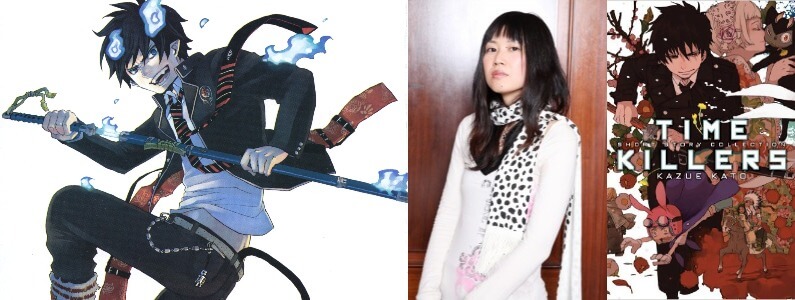
Kazue Kato is the mangaka behind the series Blue Exorcist. She is the winner of the Tezuka Award for her manga Boku to Usagi (“Rabbit and I”), which she received when she was only 19 years old. She has also written a sci-fi manga titled Robo to Usakichi. Last year, Viz Media published Time Killers in North America, which is a collection of short stories written by Kato that also includes a translation of Boku to Usagi. The short stories feature story elements and characters designs that have worked their way into Blue Exorcist. In an interview with Anime News Network, Kato explained that the inspiration for Blue Exorcist was a Brothers Grimm fairytale that involved brothers fighting monsters. She also mentioned that she didn’t expect her manga to be adapted into an anime: “I was frantically trying to not miss my deadlines. But, looking back, I should have thought about the possibility of it becoming an animated series.” Kato talked about how she thought of the biblical references in Blue Exorcist pragmatically at first, but because of the manga’s international release, has developed some worries over them:
I made biblical references with the thinking that “I should not run away from these references if I’m working in the Exorcist genre.” But, I understand that Western countries are more sensitive to stories with biblical references than Japan is. Right now, the “Blue Exorcist” manga is currently being translated in France, UK, and the U.S. I was surprised to see some of the translations, and thought, “Is it okay to translate that part?” or “Could the fans in Christian countries enjoy reading this?” I got those feelings. I still get those feelings.
CLAMP
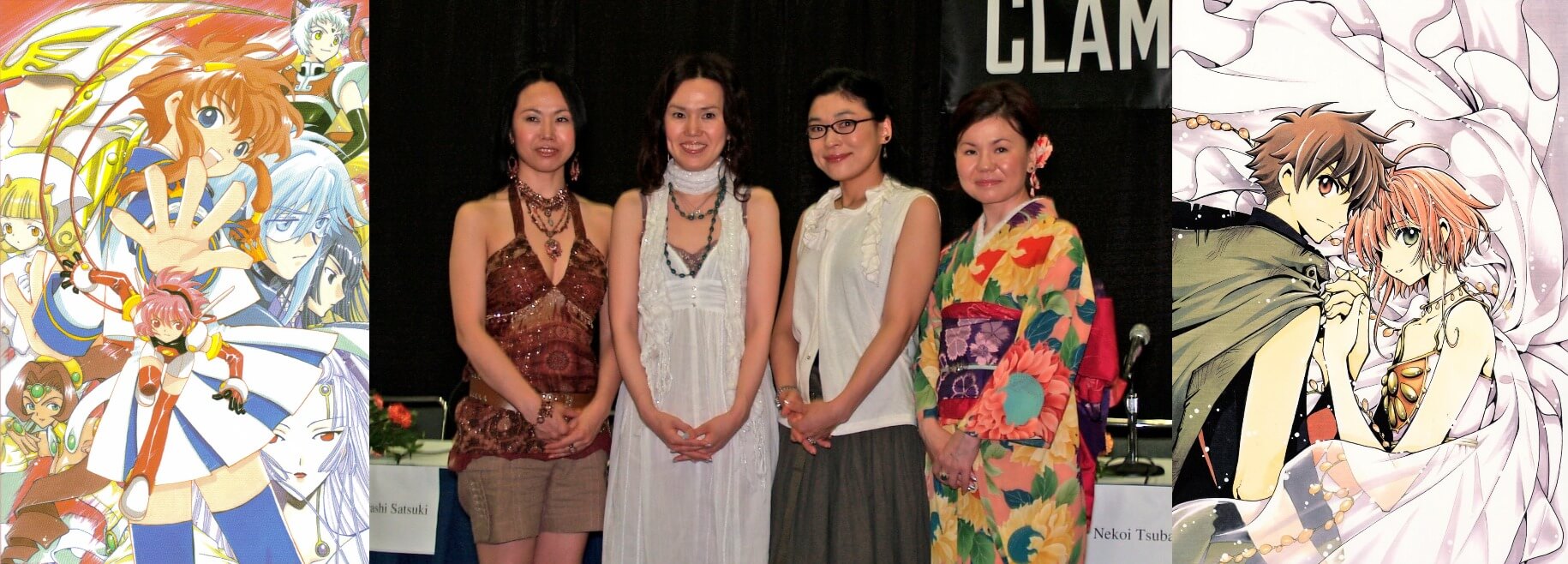
Of all the mangaka featured in this article, the women of CLAMP are the most versatile when it comes to genre, with works that fall under shoujo, shounen, josei (aimed at older women), and seinen (aimed at older men). Their shounen titles include: Angelic Layer, Man of Many Faces, Duklyon: Clamp School Defenders, Tsubasa: Reservoir Chronicle, and Gate 7. While CLAMP started out as an eleven-member doujinshi circle, the group has consisted of the same four women since 1993: Nanase Ohkawa, Mokona, Satsuki Igarashi, and Tsubaki Nekoi. As a group, they have published over 20 different works, making them the most prolific mangaka on our list. Three of their works are currently on hiatus: X, Gate 7, and Drug & Drop (formerly titled Legal Drug). In the meantime, the team is working on two sequel manga: xxxHolic: Rei and Tsubasa World Chronicle: Nihai Kanai-hen.
Others
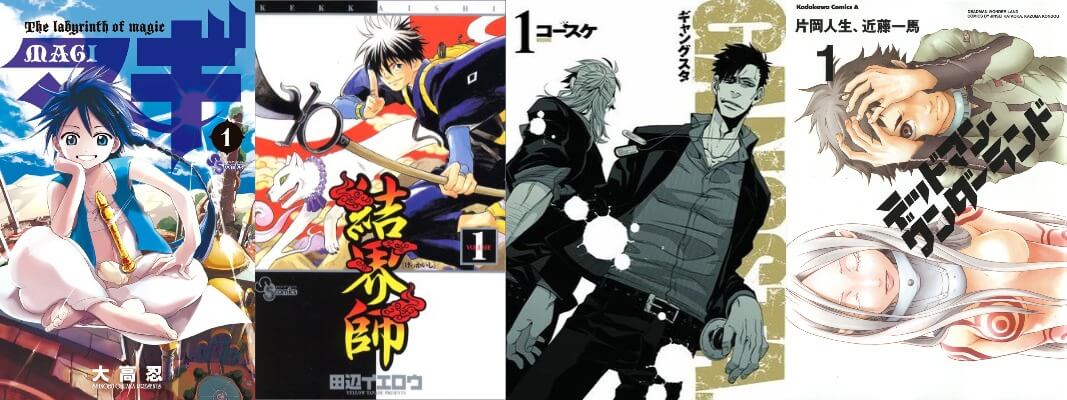
There are plenty of other women who have written shounen works. Shinobu Ohtaka is the author of Magi: The Labyrinth of Magic, which has been collected into 27 volumes so far and made into an anime by A-1 Pictures that consists of two seasons: Magi: The Labyrinth of Magic and Magi: The Kingdom of Magic. She also wrote a spin-off manga titled Adventure of Sinbad with illustrations provided by Yoshifumi Ohtera. This spin-off has also been adapted into an OVA, and an animated television series is planned for release in 2016. Yellow Tanabe wrote the series Kekkaishi, which earned her a Shogakukan Manga Award for a shounen series. Kohske is a relatively new mangaka, with Gangsta. being her first manga series. It was adapted into an anime earlier this year. Jinsei Kataoka wrote the manga Deadman Wonderland alongside Kazuma Kondou as the illustrator. The pair also worked on the manga adaptation of Eureka Seven.
These are only a handful of the women who have written or are currently writing shounen manga. Were you surprised to learn one of your favorite shounen manga series was written by a woman? Is there anyone not on this list whose manga you enjoy? Let us know in the comment section!
Sources: Furinkan, Asahi, Comic Book Resources, Comi Press (1 & 2), Anime News Network (D. Gray-man, Kazue Kato interview), The Mary Sue, Animeland (original interview and translation), Amazon, Wikipedia (CLAMP, Magi: The Labyrinth of Magic, Yellow Tanabe, Gangsta., Deadman Wonderland, and Eureka Seven)

Featured Sponsor - JAST
The sweetest romance and the darkest corruption, the biggest titles and the indie darlings; for visual novels and eroge, there's nowhere better.
Big thank you to our supporters
From their continous support, we are able to pay our team for their time and hard work on the site.
We have a Thank-You page dedicated to those who help us continue the work that we’ve been doing.
See our thank you page